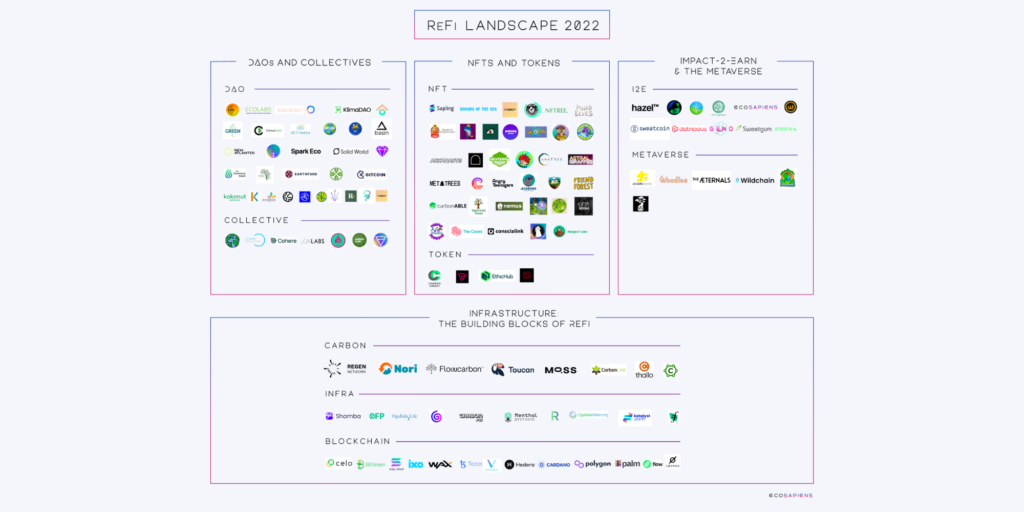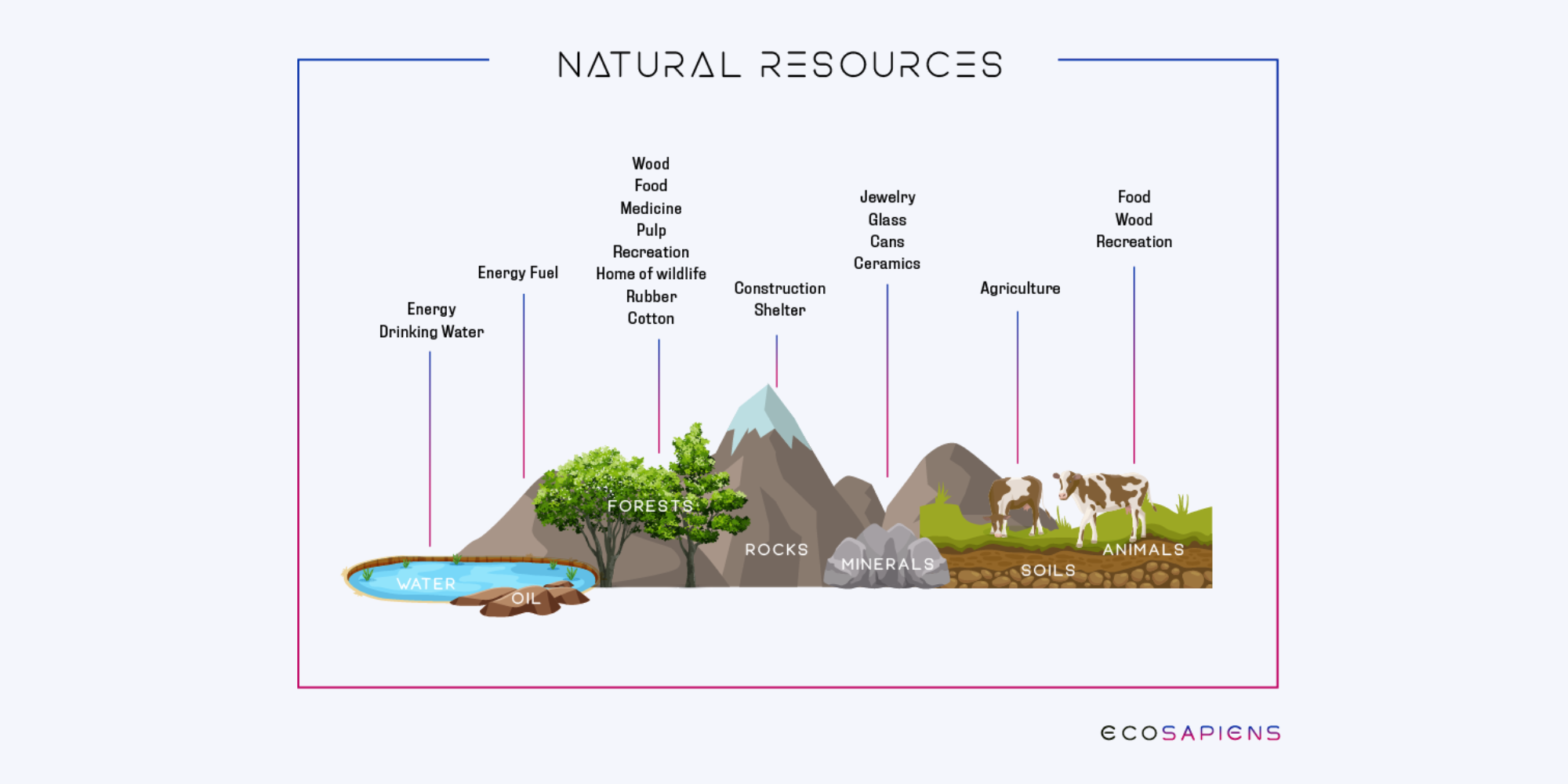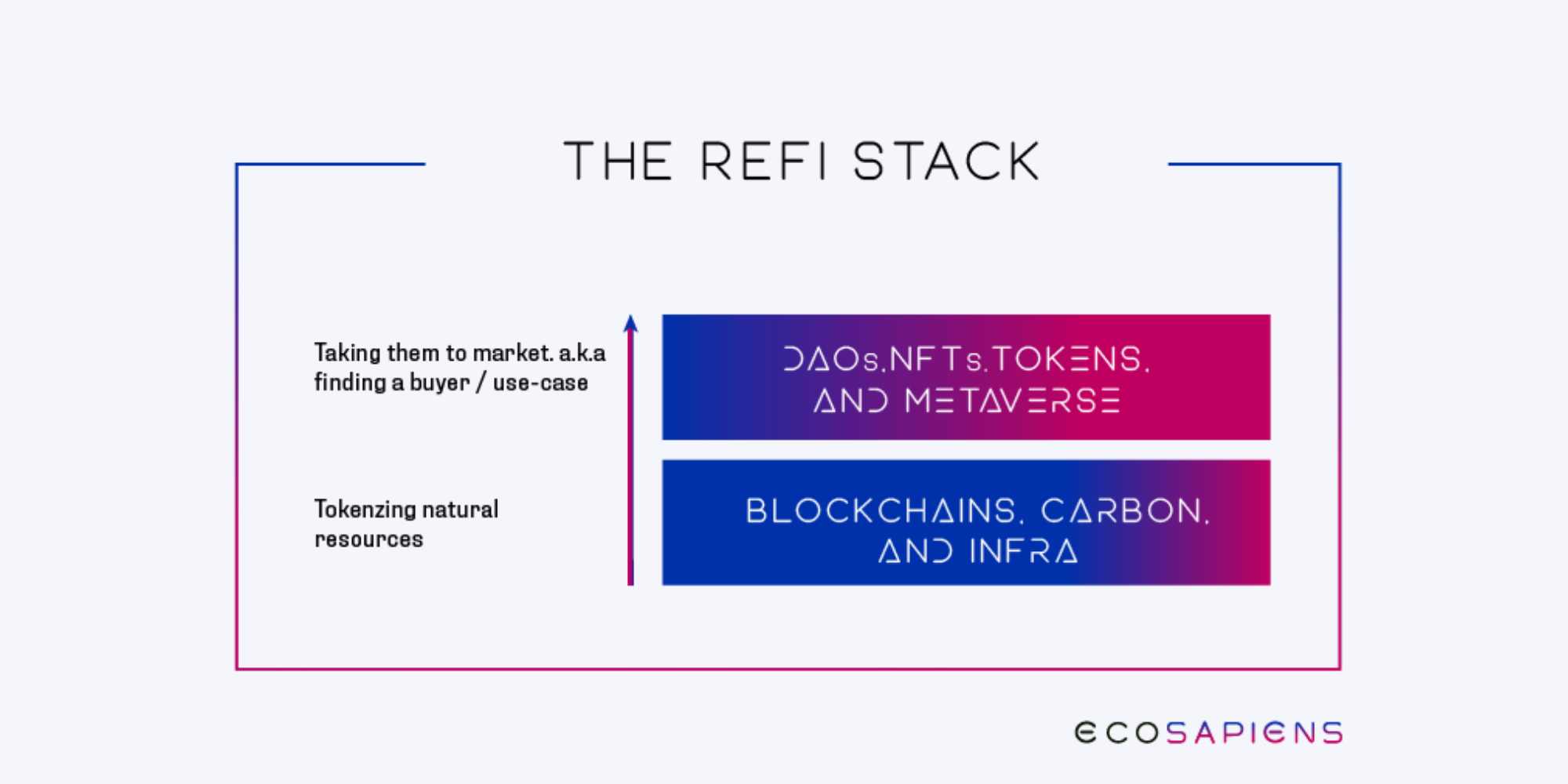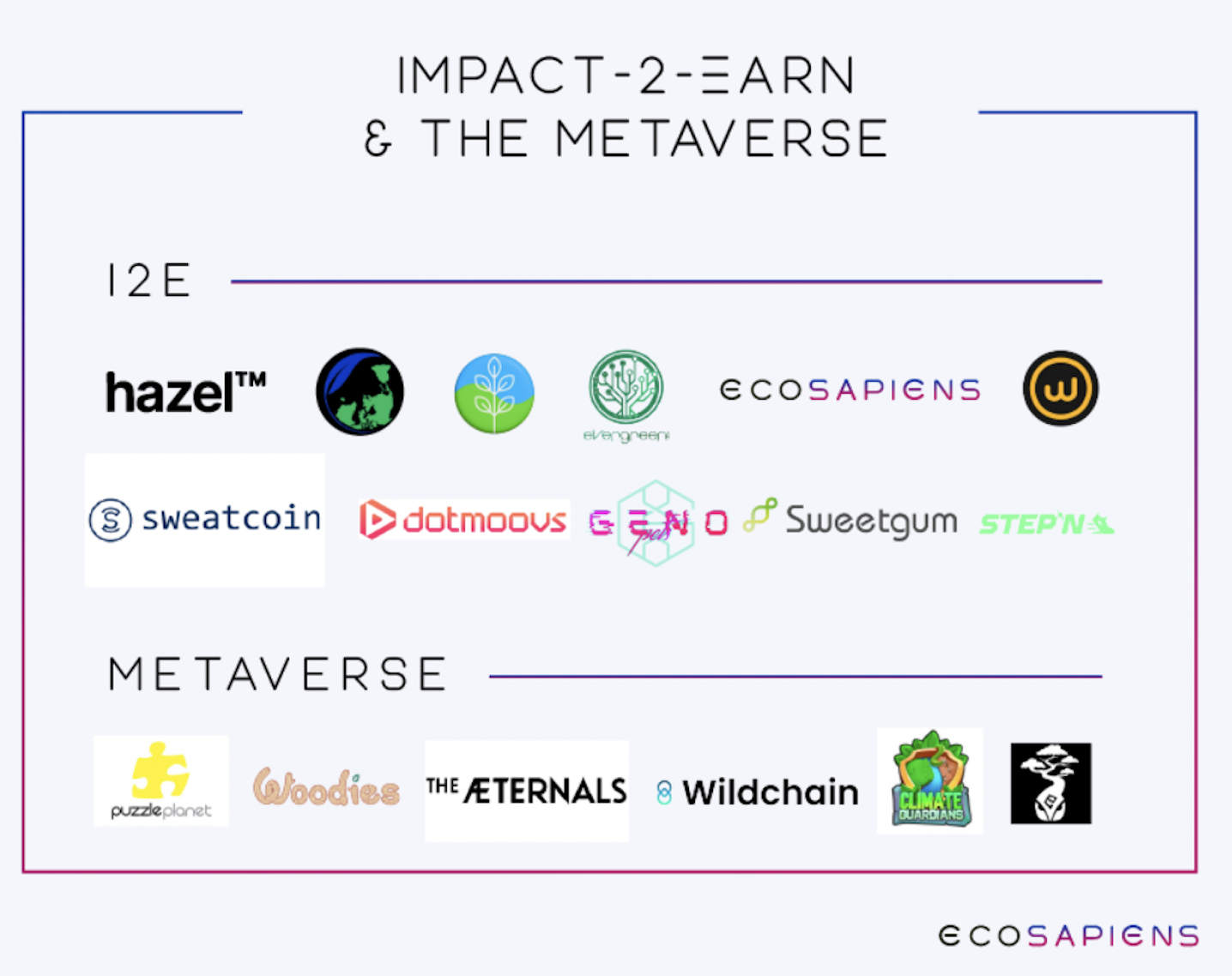- An Introduction to Regenerative Finance
- Regenerative Finance: Using Financial Motivation to Incentivize the Regeneration of Natural Resources
- Final Thoughts: Build the Ground Up from the Ground Up
Regenerative Finance, or ReFi, is an experiment to create financial incentives to draw down carbon emissions, “regenerate” the environment and ultimately reverse climate change.
Sounds wild, huh?
But, here’s the crazier part—it might actually work.
The following guide to ReFi isn’t a vaporware pitch or a ploy to sell you a useless token. This ReFi guide’s goal is to drive awareness into how this niche, but fast-growing sector may develop some of the key infrastructure and applications needed to make a regenerative economy significantly more attractive, and drive positive climate action.
By the end of this read, I hope you, too, become optimistic about the power of crypto to make a dent in climate change.
A bit about me, my name is Nihar Neelakanti, Co-founder and CEO of Ecosapiens, a metaverse enabling consumers to fight climate change. Our alpha product is the world’s first carbon-backed NFT.
Let’s start at the beginning.
An Introduction to Regenerative Finance
Fossil fuels get plenty of flack, but they’ve been an undeniable miracle for humanity. They’ve stimulated productivity and industrialization that lifted billions of people out of poverty, improved our overall quality of life, and increased our longevity—among other enhancements in the human condition.
However, the miracles brought about by fossil fuels have come with a price: carbon emissions released due to our economic activity have directly resulted in the rise of global temperatures. These increases in temperatures hurt all of us. The worst consequences of global temperature rise include engulfing sea levels, human displacement, drought, floods, and an intensification of natural disasters.
A few moonshot ideas exist to help mitigate and adapt to climate change, including direct air carbon capture, fusion energy, and even the colonization of Mars.
Today, we’re looking at something very much within reach—how crypto can
- incentivize the reduction of the global carbon footprint, and
- regenerate natural resources.
And no, this isn’t another one of those “slap a blockchain tag on it and raise money” ideas—the actual execution here is fascinating.
Take these examples:
- StepN, a web3 lifestyle app, has managed to shrink its users’ carbon footprint by nearly 6 million tonnes by incentivizing them to … walk more.
- Gitcoin, the leading crypto-based, open source bounty platform, has created a channel for individuals and organizations to deploy nearly $65M USD in over 2,800 web3 for public goods projects via quadratic funding.
- KlimaDAO has rallied its community to absorb nearly 18M tonnes of carbon credits, equivalent to taking 3.8 million cars off the road for a year.
Founded in 2017, Gitcoin was a pioneer in the space, with the founder Kevin Owocki quite literally writing the book on ReFi: Greenpilled: How Crypto Can Regenerate the World.
There are over 100 ReFi companies today, and the pace continues to grow. Many notable venture capital institutions such as a16z and USV are actively investing in the category; new funds like Allegory are focused exclusively on the intersection of crypto and climate.
Industrial Economic Theory: A Story of Extraction
The utilization of natural resources is fundamental to developing an economy.
According to the factors of production economic model, when we combine Land* (natural resources), Labor, and Capital with Entrepreneurship, we get Production (value creation). The fruits of production advance economies and improve productivity and quality of life.
*Note: Throughout this article, capitalized “Land” refers to natural resources.
More resources mean faster economic growth and, ideally, a better quality of life for everyone.
Here are a few examples of natural resources:
While natural resources can be replenished, overexploitation can lead to a resource’s total collapse. What happens when natural resources (“Land”), one of the pillars of the factors production, disappear?
We have two dichotomies to examine humanity’s relationship with the environment’s finite resources—Man vs. Man and Nature vs. Man.
Scenario 1: Man vs. Man
Ancient Greeks and Romans are some of the earliest examples of scaled resource extraction.
“Forests provided the major material for construction and almost the only fuel source of the classical world, and depletion of this source precipitated several crises,” note J. Donald Hughes with J. V. Thirgood in “Deforestation, Erosion, and Forest Management in Ancient Greece and Rome,” Journal of Forest History 26, no. 2 [April 1982], p. 60). “As forests retreated with land clearance, wood decreased in availability and increased in price, contributing to the ruinous inflation that plagued late antiquity. Competition for forest resources ignited military conflicts, creating timber demands.”
Once a local resource has been depleted, civilizations start to look elsewhere to replenish those resources, often by expanding their empires through trade or, worse yet, military force.
In this instance, we see Man competing with Man for more resources.
Scenario 2: Nature vs. Man
When we exploit natural resources beyond their ability to regenerate, we are missing resources and can be left with negative externalities that further degrade society.
Look no further than the Mayans for a historical warning. In the 9th century CE, the Mayan Empire was one of the most prosperous civilizations in the world—then suddenly, it was gone. The best possible explanation for its mysterious disappearance is that it resulted from drought due to deforestation.
The Mayans transformed the land to sustain one of the highest population densities in history. They removed nearly all of the forest and replaced it with agricultural crops. … By cutting down the forest, the Mayans changed their local climate. … Rainstorms became less common. (NASA Earth Observatory, paras. 2–3)
Humans are experiencing the same problem today: the combustion of fossil fuels and exploitation of our forests and oceans result in negative externalities that impact human health and cost our economy an increasingly large amount of money. In this contest between Man and Nature, Nature is defeating Man.
The industrial economic theory works perfectly when Land, Labor, and Capital are present, but the cycle of prosperity breaks when Land no longer exists.
This diagram is at the heart of two frequently politicized tugs-of-war: Nature vs Man and Man vs Man.
To break the combative cycle of Man vs. Man (or Nature vs. Man) in our collective race to acquire relatively finite resources, we need to create an economic system where industrialists (capitalism maxis) are directly incentivized to improve the planet and replenish natural resources.
Regenerative Finance: Using Financial Motivation to Incentivize the Regeneration of Natural Resources
At its most fundamental level, ReFi is the idea of appraising the value of natural resources—not based on the cash flows from their exploitation but rather on their preservation and regeneration.
For example, if you are a landowner in the Amazon today, imagine that you could generate greater ongoing economic value from preserving the rainforest than from deforesting the land for timber, agriculture, or cattle grazing.
Better still, imagine it was financially attractive to seek out barren land and actively invest in reforesting it.
This approach results in the generation of Land, which mobilizes the factors of production and leaves an individual with more $$ in their pocket.
Imagine that—a way forward to simultaneously remedy the planet and advance the economy. It’s a win-win.
For a regenerative economic model to work, we have to:
(1) determine the value of preservation/regeneration,
(2) package it into a tradable asset,
(3) create liquidity for that asset.
Step 1: Pricing Natural Assets by Their Value as Carbon Sinks
The concept of a carbon market was unveiled in the 1997 Kyoto Protocol as a mechanism to incentivize carbon-emission reduction.
By placing a price on carbon, the Protocol presented a unique environmental commodity on an international scale.
Natural assets can now be priced by their value as “carbon sinks,” a.k.a. society’s valuation of a ton of carbon removed from the atmosphere. When we remove carbon from the air, we reap cleaner air, lower temperatures, and create other positive externalities. These positive effects can be financially quantified by the tonne and qualified into what is a carbon credit.
In essence, the price of a ton of carbon is derived not from the creation of a ton of emissions; instead, it is based on the value of the positive externalities derived from the removal of a ton of carbon emissions.
As a result, forests, oceans, and other natural resources can be valued according to the amount of carbon they capture. For example, the higher the price per ton of carbon, the more attractive it becomes to get into the business of planting new forests (and deriving income from carbon credits) instead of cutting down the trees for timber.
This lure has been increasingly effective since 2019, when the price per ton of carbon crossed 40 USD—a critical threshold in making nature-based regeneration (trees, kelp, soil, etc.) significantly more financially motivating, leading to a boom in tree planting.
The price climb is largely due to demand outpacing supply. We won’t go too deep into the demand forces of carbon in this article, but to keep it plain and simple, there are several buyers of these carbon credits. Some are polluters who are required to purchase these credits due to regulatory requirements; in recent years, however, an increasing number of enterprises such as Stripe, Microsoft, Amazon, United Airlines, and others have been buying them voluntarily to help achieve their own net-zero targets. For a deep dive on the carbon credits, see this McKinsey report.
Data from CarbonCredits.com
Now that we’ve established what a carbon is, let’s explain how they are issued. First, for a carbon sink (let’s use a reforested hectare of land) to get issued a carbon credit, the carbon capture potential of that forest has to be measured, reported, and verified (MRV) by the tonnes of carbon captured over the lifetime of the project.
Several new companies are leveraging lidar, satellite imagery, and drones to achieve MRV at lightning speeds and lower cost; Perennial Earth is one company that is scaling up MRV for carbon soils.
Once MRV is completed, these carbon credits are issued by agencies such as Verra and CAR, among others, and sold via brokers, eventually making their way to buyers.
The process of linking carbon project developers with MRV and ultimately the buyer is incredibly complex, bottle-necked, and mired with transparency and duplicity issues.
Blockchain technology can streamline the issuance and liquidity side of carbon and make it more equitable for all parties involved.
Step 2: Tokenizing Carbon with Crypto: Introducing ReFi
ReFi is regenerative finance on the blockchain.
Once the natural resources mentioned above undergo MRV for the value of their carbon sink, that value needs to be turned into a credit (a tradable asset) and then has to find a buyer (market) .By taking carbon and issuing it on the blockchain, we can bypass a number of these steps and bring carbon projects to market faster, increasing liquidity for the carbon, which could send a vibration back through the market and make regeneration more financially attractive given the liquidity premium.
Not only that, but blockchain also removes the potential for duplicity and improves the transparency of carbon credits—a problem that plagues the carbon markets.
There are two parts to the ReFi stack:
- the tokenization and infrastructure layer, which creates the credit, and
- the application layer aims to create a use-case/buyer market for such credits.
Infrastructure: The Building Blocks of ReFi
The foundational layer that enables the whole ReFi system to run includes Layer 1s, Layer 2s, carbon suppliers, and infrastructure tools.
Layer 1s are carbon-neutral or -negative proof-of-stake blockchains like Solana that are highly energy efficient. Once Ethereum shifts to POS, it can also be considered an L1 for the ReFi economy. Layer 2s like Polygon also fall in this bucket. In other words, these are all existing blockchain projects that don’t take enormous resources to run.
Carbon suppliers are the carbon brokerages responsible for bringing carbon on-chain to underpin other applications. Nori, a pioneer in the space, wrote about the tokenization of carbon back in 2017. Today, there are several projects in the carbon supply niche, including Toucan Coin, Flow Carbon, and Regen Network.
Infrastructure tools are loosely defined as data products, protocols, and adjacent tooling that support carbon suppliers and core blockchains in distributing carbon to the application layer.
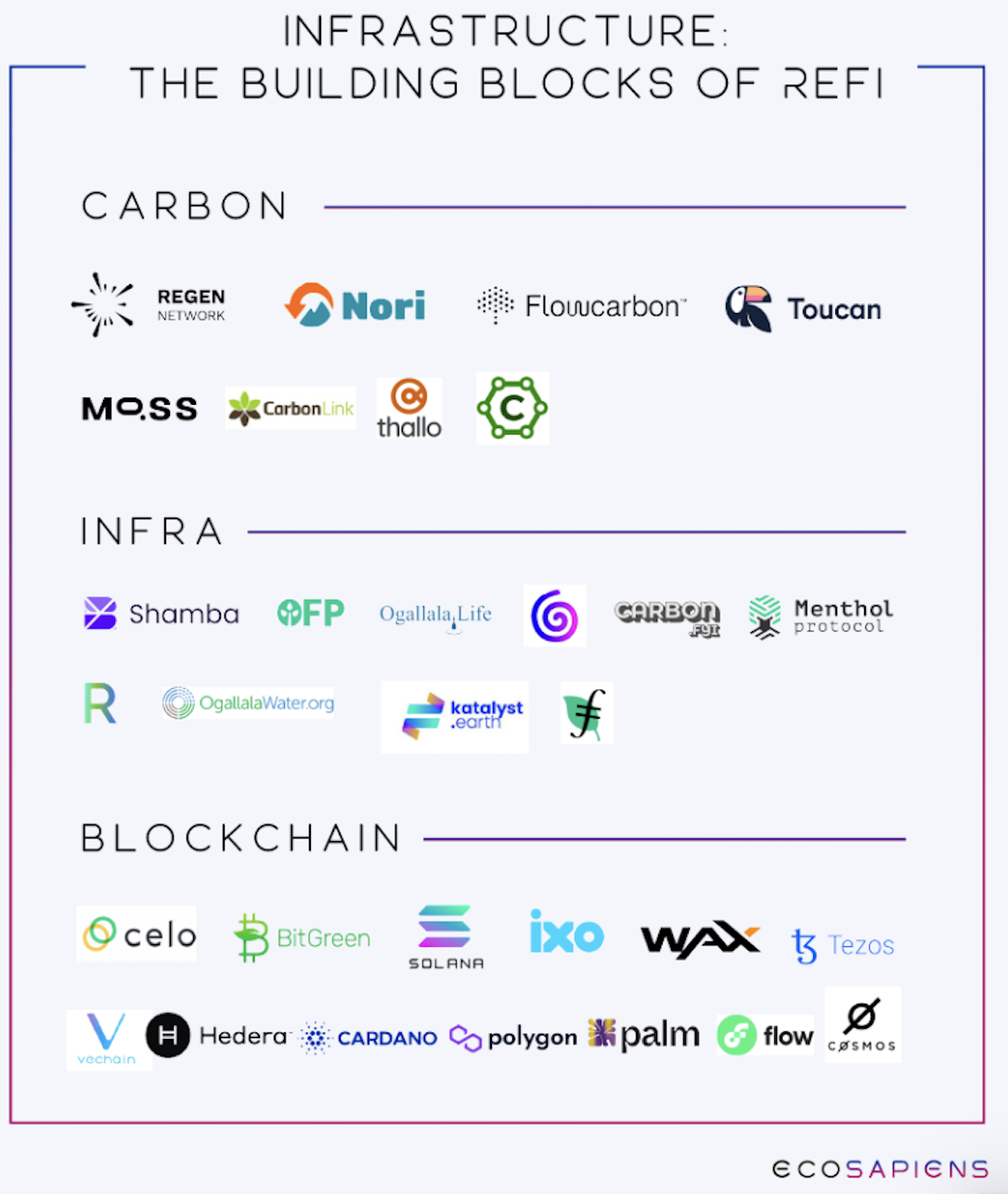
List of ReFi Projects: Applications Turning Degens into Regens
A myriad of applications run on this base infrastructure layer.
The obvious use case is to take the tokenized carbon itself and send it directly to the existing buyers’ market (large enterprises).
But the blockchain enables a broad, sweeping wave of creativity; dozens of ambitious ReFi founders are bringing regeneration to the forefront of community and consumers in compelling ways beyond simply distributing carbon. They are incentivizing individuals and orgs to shrink their own carbon footprint and those of their communities.
We’re tracking three primary application categories:
- Impact-2-Earn/metaverse,
- DAOs,
- NFTs/tokens.
Impact-2-Earn and the metaverse are comprised of companies leveraging tokenomics and game/culture to incentivize frictionless real-world impact.
For example, someone can walk more and be rewarded with carbon tokens, reducing their carbon footprint in the process.
Move-to-Earn models (part of a broader Impact-to-Earn ecosystem) are in their infancy, but we’ve seen several apps like StepN and Sweatcoin gain a foothold (I’m sorry) in the market.
Several metaverse applications aim to make carbon reduction and environmental restoration fun and accessible in a virtual setting.
For example, Climate Guardians introduce a play-to-preserve model whereby interacting with in-game NFTs preserves the Amazon rainforest in real life. On the backend, a portion of proceeds from NFTs goes toward retiring carbon credits tied to the Amazon. Players can even vote upon and direct where these funds are allocated.
Another application, Wildchain, allows users to adopt and raise rare species in their mobile game digitally: 100% of profits generated from the sale of their NFTs go toward supporting wildlife rangers, protecting natural wildlife habitats, planting trees, and employing local people in the physical world.
At the time of writing, its community has “adopted” 3,187 animals, planted 18,300 IRL trees, and created 183 employment workdays for real people on the ground.
Plant a tree in the metaverse = get a tree planted IRL.
We classify our own company, Ecosapiens, in this category. We’re on a mission to easily enable any individual to fight climate change with the world’s first carbon-backed NFT. Ownership grants you access to the Ecoverse, our vision for a full-stack sustainability platform, DAO, and metaverse.
DAOs and collectives organize individuals to drive capital or time toward real-world impact.
Organizations harness the power of ownership to collectively organize individuals to provide grants, investment, mindshare, marketing, and insight to stimulate the community and further drive IRL impact.
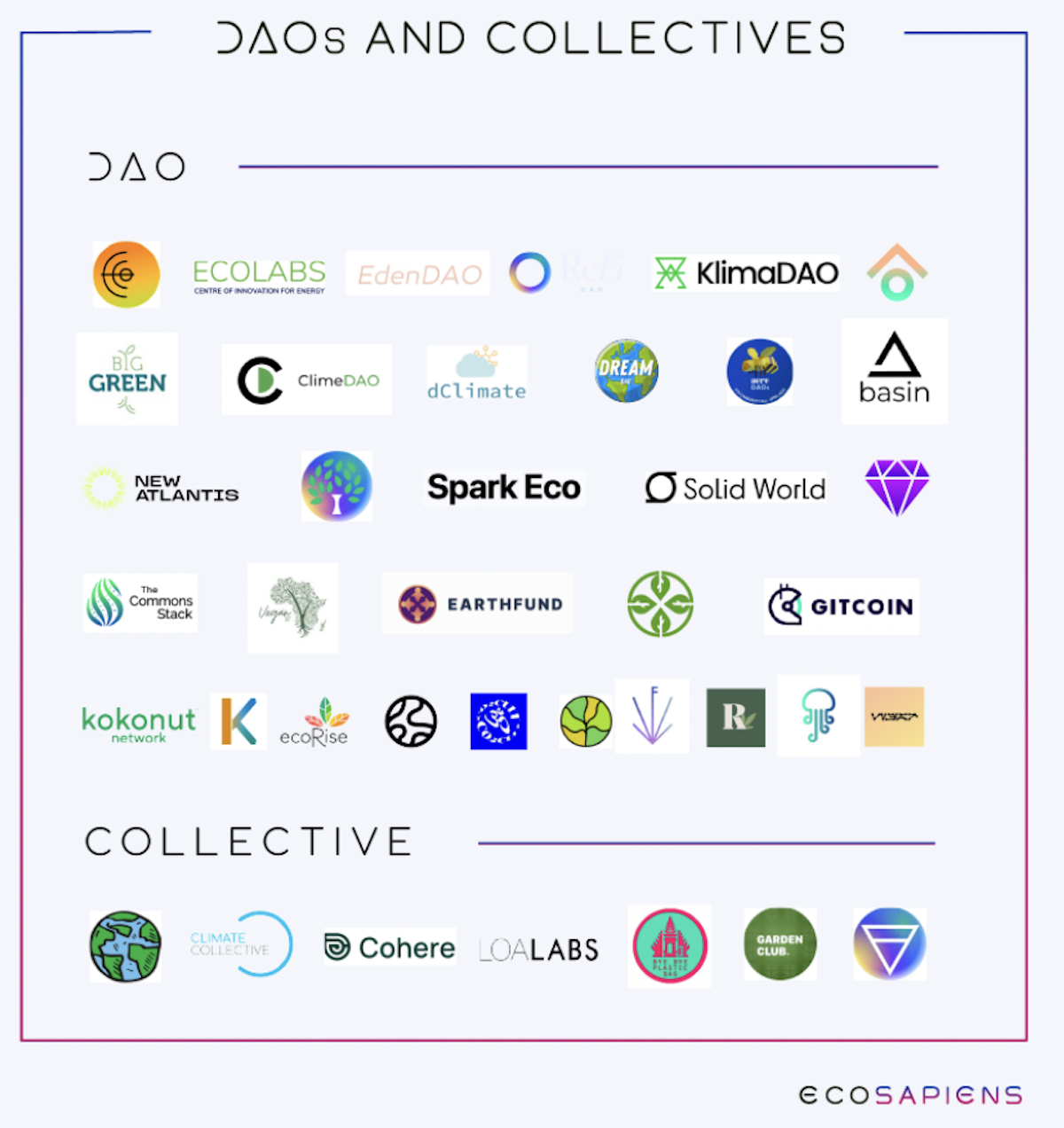
Carbon isn’t materially underpinning these organizations, but DAOs and other crypto-based collectives aggregate voice, influence, and marketing with basic blockchain-based infrastructure support.
Gitcoin and ReFi DAO are two notable players in this part of the ecosystem.
NFTs and tokens are the “Greenchips” driving capital and culture toward climate action.
While there are several “bluechip” NFTs, such as CryptoPunks and Bored Ape Yacht Club, many upstart founders are leveraging NFTs, a.k.a. the Greenchip NFTs, to redirect dollars in crypto toward planet-friendly causes like animal conservation, biome restoration, carbon sequestration, and other natural resource protection projects. While early, tokens represent an alternative method to NFTs as a way to access positive impact projects through crypto.
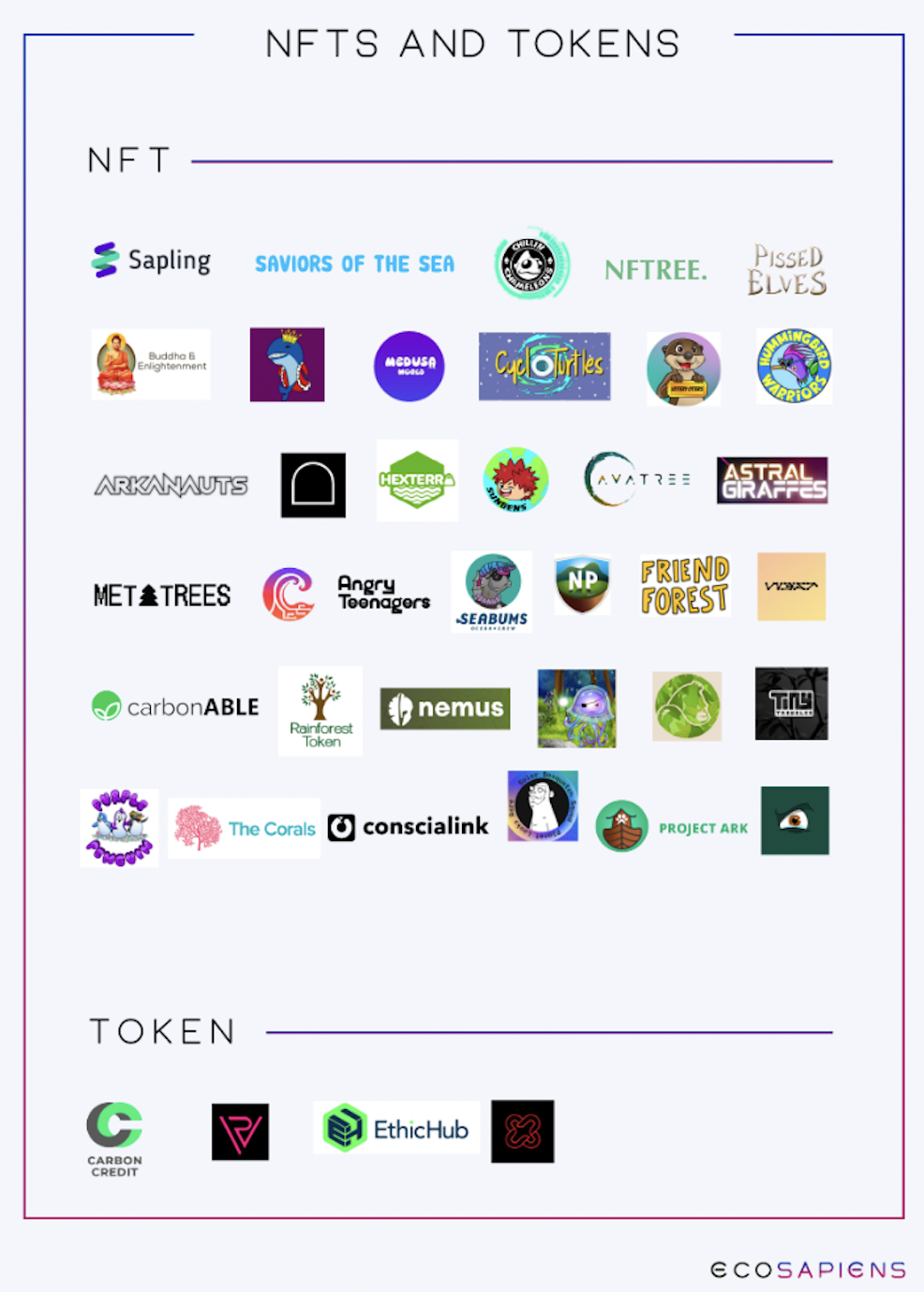
These assets are liquid on marketplaces such as Opensea, Voice.com (the leading carbon-neutral NFT marketplace), Nifty Gateway, SushiSwap, and others.
Final Thoughts: Build the Ground Up from the Ground Up
“There are no passengers on Spaceship Earth. We are all crew.”
Web3 and blockchain technology gave us a new lens to view problems spanning decades, if not centuries—but its reputation is largely based on its singular focus on profit.
ReFi aims to use crypto for good by harnessing the potential at the intersection of profit and purpose and introducing the idea that it pays to help the planet.
In a way, it’s one of the most vibrant sandboxes for building blockchain-based applications with the mass appeal without the “crypto people building for crypto people” stigma looms over the cryptocurrency industry.
We still have a long way to go, but these projects are mission-driven and determined to build through the bear market because, after all, our planet knows no bull or bear, except actual bulls and bears, of course.
We all have the potential to make a material impact through the power of community and web3– the magic is in tying a real-world human incentive to turn Degens into Regens. In doing so, we can leverage this “magic internet money” and its associated technology to heal our Home.
Never Miss Another Opportunity! Get hand selected news & info from our Crypto Experts so you can make educated, informed decisions that directly affect your crypto profits. Subscribe to CoinCentral free newsletter now.






